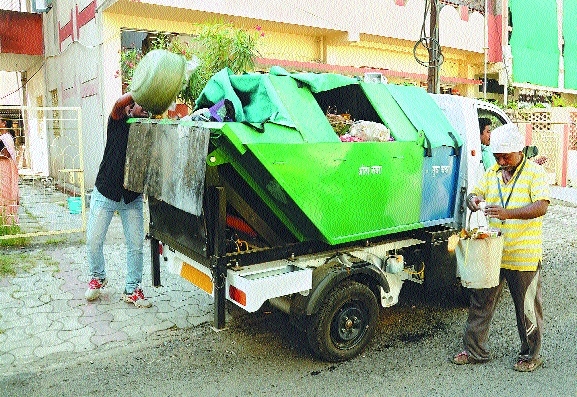LIG, HIG highest generators of plastic waste in city
| Date :06-Apr-2021 |

Citizens dumping garbage in a mobile garbage van. (Pic by Satish Raut)
By Kaushik Bhattacharya :
City generates 1,150-1,200 tonnes of MSW per day and processes only 150-200 TPD of waste
Low and high income groups generate 16.54% and 14.36% of plastic waste per day respectively
Low Income Group (LIG) and High Income Group (HIG) of Nagpur city are generating highest 16.54% and 14.36% of plastic waste per day respectively, revealed the Environment Status Report (ESR) of CSIR-National Environmental Engineering Research Institute (CSIR-NEERI). Nagpur is generating an average of 1,150-1,200 tonnes per day (TPD) of Municipal Solid Waste (MSW), with an average per capita waste generation of 4.46 kg out of which only 150-200 TPD of waste is being processed.
CSIR-NEERI conducted a study where it collected MSW samples from different socio-economic groups that is Low Income Group (LIG), Middle Income Group (MIG) and High Income Group (HIG) covering all the 10 zones of the city. The samples were collected from 23 different locations in the city. Though the LIG is producing less amount of waste per day, it is the highest plastic waste generating group with 16.54%, the study revealed. The study is distributed in five categories of waste that is organic, paper, plastic, metals and glasses, and inert. Organic waste generation is highest in all groups but plastic and inert waste generation are also in higher side. The HIG which is well educated and well-to-do group is also generate 14.36% plastic waste in the city. However, MIG generates 2.1% of plastic waste per day. In over all category, MIG and HIG are observed to produce the higher amount of waste as compared to the LIG. Generation of inert waste in the city is also in higher side. Inert waste is neither chemically nor biologically reactive and will not decompose or only very slowly. Examples of this are sand and concrete.
LIG and MIG are observed to produce the higher amount of inert waste as compare to HIG. “It is evident from the data that Maharashtra Plastic and Thermocol Products (Manufacture, usage, sale, transport, handling and storage) Notification, 2018 is not being followed and implemented. Around 60% of plastic waste that is collected in India is single use plastic, which can be projected in Nagpur as well,” said Surbhi Jaiswal, Team Lead, Green Vigil Foundation. “Single use plastic eradication is of utmost concern on first hand. Single use plastic are the major cause of concern as it ends up in water bodies and dumping areas of our cities.
Citizens are certainly aware about plastic ban and usage, but are not conscious enough to restrain from using it,” she added. SWM is realised as one of the major problems in the city by NMC. The increase in the quantity of the waste generated, regular change in the quality of waste and inappropriate processing and disposal method is the main aspects involved in SWM. There should be focus on designing intelligent machines for segregation and disposal of wastes in line with intelligent vending machines. One of the prime hindrances in waste management is the revenue needed for different aspects the process. Evidently, the study stated that the waste management system in Nagpur is presently inadequate and improvement is needed to maintain our environment and keep our city clean.